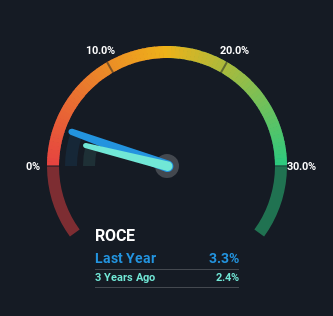- Hong Kong
- /
- Trade Distributors
- /
- SEHK:599
Returns On Capital At E. Bon Holdings (HKG:599) Paint A Concerning Picture

If you're looking at a mature business that's past the growth phase, what are some of the underlying trends that pop up? Businesses in decline often have two underlying trends, firstly, a declining return on capital employed (ROCE) and a declining base of capital employed. Basically the company is earning less on its investments and it is also reducing its total assets. And from a first read, things don't look too good at E. Bon Holdings (HKG:599), so let's see why.
Understanding Return On Capital Employed (ROCE)
For those that aren't sure what ROCE is, it measures the amount of pre-tax profits a company can generate from the capital employed in its business. Analysts use this formula to calculate it for E. Bon Holdings:
Return on Capital Employed = Earnings Before Interest and Tax (EBIT) ÷ (Total Assets - Current Liabilities)
0.033 = HK$18m ÷ (HK$711m - HK$177m) (Based on the trailing twelve months to March 2024).
So, E. Bon Holdings has an ROCE of 3.3%. In absolute terms, that's a low return and it also under-performs the Trade Distributors industry average of 5.9%.
See our latest analysis for E. Bon Holdings

While the past is not representative of the future, it can be helpful to know how a company has performed historically, which is why we have this chart above. If you want to delve into the historical earnings , check out these free graphs detailing revenue and cash flow performance of E. Bon Holdings.
The Trend Of ROCE
We are a bit worried about the trend of returns on capital at E. Bon Holdings. About five years ago, returns on capital were 4.6%, however they're now substantially lower than that as we saw above. On top of that, it's worth noting that the amount of capital employed within the business has remained relatively steady. This combination can be indicative of a mature business that still has areas to deploy capital, but the returns received aren't as high due potentially to new competition or smaller margins. If these trends continue, we wouldn't expect E. Bon Holdings to turn into a multi-bagger.
The Bottom Line
In summary, it's unfortunate that E. Bon Holdings is generating lower returns from the same amount of capital. It should come as no surprise then that the stock has fallen 49% over the last five years, so it looks like investors are recognizing these changes. Unless there is a shift to a more positive trajectory in these metrics, we would look elsewhere.
On a final note, we found 3 warning signs for E. Bon Holdings (1 is a bit unpleasant) you should be aware of.
While E. Bon Holdings may not currently earn the highest returns, we've compiled a list of companies that currently earn more than 25% return on equity. Check out this free list here.
Valuation is complex, but we're here to simplify it.
Discover if E. Bon Holdings might be undervalued or overvalued with our detailed analysis, featuring fair value estimates, potential risks, dividends, insider trades, and its financial condition.
Access Free AnalysisHave feedback on this article? Concerned about the content? Get in touch with us directly. Alternatively, email editorial-team (at) simplywallst.com.
This article by Simply Wall St is general in nature. We provide commentary based on historical data and analyst forecasts only using an unbiased methodology and our articles are not intended to be financial advice. It does not constitute a recommendation to buy or sell any stock, and does not take account of your objectives, or your financial situation. We aim to bring you long-term focused analysis driven by fundamental data. Note that our analysis may not factor in the latest price-sensitive company announcements or qualitative material. Simply Wall St has no position in any stocks mentioned.
About SEHK:599
E. Bon Holdings
An investment holding company, engages in the importing, wholesale, retail and installation of architectural builders’ hardware, bathroom, kitchen collections, and furniture in the Hong Kong and the People’s Republic of China.
Flawless balance sheet with acceptable track record.
Market Insights
Community Narratives



